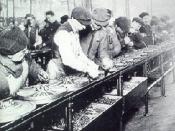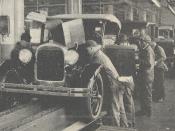The 1920's were a period of tension between new and changing attitudes on the one hand and conservative values on the other. In fact, some historians refer to the twenties as the first decade of the twentieth century. What accounts for this observation? How did some people challenge those changes?A major fact that contributes to the twenties being seen as the first decade of the twentieth century is that modern attitudes about labor and consumption began to develop. The system of Fordism, or mass production, involved the usage of interchangeable parts and electric power so that production could be as fast as possible. Conveyor belts were employed to move subassemblies past workers who tightened a few bolts or installed one part. This assembly line method led to a major increase in output. The managers at the factories were very concerned with the speed of production and did everything in their power to ensure that it was very fast.
Workers were laboring under more intense supervision compared to previous years. They were being encouraged to work more efficiently. For example, in textile factories there was a higher quota of looms that the workers had to meet. Less satisfying work accompanied mass production. It was monotonous and required little to no skill. These workers sought pleasure through the consumption of goods and services, known as consumerism. Those that were middle-class workers were being paid more and had more vacations. They also contributed to consumerism. More money was being spent on advertising campaigns that promoted the usage of modern goods by the American public. Advertising is a major part of the marketing world today and contributes to people buying certain products.
The emphasis on pleasure, as demonstrated by consumerism is evident in the fact that spectator sports, radio, and movies were a major...


